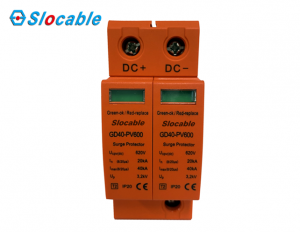1. Selection criteria
When selecting SPD for equipment, we should consider not only the location of equipment but also the distance between IT and other equipment, and the planning of power grid should be considered firstly (such as TN-S, TT, IT system, etc.) . Placing the SPD too close or too far can have an unfortunate effect on the protection of the device (too close causes the device and the SPD to oscillate, too far can be ineffective) .
In addition, the selection of the SPD should also take into account the current at the device, ensure that the selected SPD components have a large capacity, evaluate the SPD according to the data obtained from the manufacturer and take into account the service life of the surge protection device, choose non-aging.
It should also be noted that the maximum continuing operating voltage (UC) of the surge protector is greater than the operating voltage of the device, and that this situation, which may have transient overvoltage (UT) , is taken into account when selecting the SPD, once there is this maybe then the surge protection device should have a lower voltage than UC. In a three-phase power system (220/380V) , only some special equipment (such as special equipment or power equipment requiring protection) shall be protected against operating over-voltage.

2. Lightning protection grade and lightning protection zone
The essence of SPD selection is to correctly recognize the voltage protection level (residual voltage) Up, the maximum discharge current, to ensure that Up is less than the voltage level of the protected equipment, and then protect the equipment. According to IEC60364-4-44, IEC60664-1 and IEC60730-1, when planning, according to the Lightning current distribution chart, lightning current shunt estimation formula and lightning current parameter table, as an important basis for selecting SPD. The first admission of building electronic information system lightning protection level.
From the “Building Electronic Information System Lightning Protection Technical Code”GB50343-2012 to confirm the lightning protection grade of buildings and the lightning current parameters after the first lightning stroke and the first lightning stroke; The lightning strike probability of the lightning current amplitude can also be obtained from the lightning strike probability curve of the measured lightning current amplitude by the annual average thunderstorm day T. E = 1-nc/n. (E indicates the blocking efficiency of protective equipment, NC indicates the maximum acceptable annual average number of lightning strikes for information system equipment damaged by direct lightning and lightning electromagnetic pulse, and N indicates the estimated annual number of lightning strikes for buildings) :
(1) Grade A when E is greater than 0.98; (2) grade B when E is greater than 0.90 is less than or equal to 0.98; (3) grade C when E is greater than 0.80 is less than or equal to 0.90; (4) grade D when E is less than or equal to 0.80;
The Lightning Protection Zone (LPZ) should be divided into non-protection zone, protection zone, first protection zone, second protection zone and follow-up protection zone. (figure 3.2.2) shall comply with the following requirements:
Direct Lightning Protection Zone (LPZOA) : no attenuation of the electromagnetic field, all types of objects may be directly struck by lightning, is a completely exposed open zone.
Direct Lightning Protection Zone (LPZOB) : the electromagnetic field does not attenuate, all kinds of objects rarely suffer direct lightning strikes, is a full exposure of direct lightning protection zone.
First Protection Area (LPZ1) : as a result of the shielding method of the building, the lightning current flowing through the various conductors is further reduced than in the direct lightning protection area (LPZOB) , the electromagnetic field is initially attenuated and all types of objects may not be subjected to direct lightning strikes.
Second Protection Area (LPZ2) : a subsequent protection area introduced by a further reduction in the induced lightning current or electromagnetic field.
(5) follow-up Protection Area (LPZN) : further reduction of lightning electromagnetic pulses is required to protect the follow-up protection area of highly sensitive equipment.
3. Backup protection for surge protectors
In order to prevent SPD from short circuit due to aging or other defects, protective methods should be installed before SPD. There are two commonly used methods, one is the fuse protection, one is the circuit breaker protection. After more than 50 planners of the query found that more than 80% of the planners used circuit breakers, which is really puzzling. The author thinks that it is a mistake to install the circuit breaker protection, and the fuse protection should be installed.
The protection of Surge Protector is short-circuit protection, there is no overload situation, using the circuit breaker can only use its three-protection (or two-protection) in the instantaneous break function.
The choice of protective equipment for surge protectors should be based on the short-circuit capacity at the SPD device. The short-circuit current of the equipment of surge protector is usually big, if use a circuit breaker, then need a circuit breaker of high subsection ability.
It is necessary to calculate the thermal stability of the conductor connected with the surge protector when using the circuit breaker. According to the short-circuit capacity of the point, the conductor section chosen will be very large and the wiring is inconvenient.
To understand the Principle of Surge Protection Device, click on the Principle of Surge Protection Device



 2022-11-22
2022-11-22















